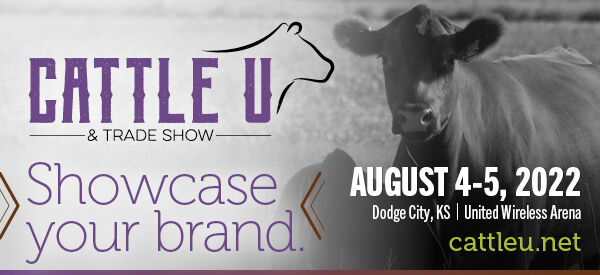Scott Schaake says he’s not a history buff—until it comes to the livestock industry. Schaake, associate professor of Beef Cattle Production and Management at Kansas State University, gave producers a beef cattle history lesson at the 2021 Cattle U and Trade Show, July 30, at United Wireless Arena in Dodge City, Kansas.
From history we can learn a lot, but we don’t need to do it again, he said.
“Christopher Columbus gets credit for bringing the first bovines we know today to the Caribbean in the late 1400s. And it really wasn’t until the early 1500s when Cortez and several Spanish explorers brought those herds of cattle up into the southern United States—a lot of them dropped off in Mexico, Texas, Florida. Really, for 300 years, they were the only beef cow that we knew in this country,” Schaake said.
During that time, the Spanish Longhorn cow “became smart. She was tough. She was wily. She could adapt to the environment. She was one of those cows that could live forever.”
Durham cattle—which cowboys called Shorthorns—were introduced into the U.S. from England in the 1800s, Schaake said, and they were bigger and fleshier. Crossbreeding began to change the look of cattle in the U.S. at that time. Herefords and Angus breeds were introduced, he said, and cattle began to filter throughout the country.
“By the early 1900s, we went from almost 4 million Longhorn cows to down to just a handful—1,800 or maybe 2,000—true Longhorn cattle,” he said.
Larger cattle were common for draft purposes in the days before tractors and other machinery helped farmers work the land. “In the early 1900s, the purebred industry boomed and flourished,” Schaake said.
At this time, the World’s Fair influenced breeding and marketing decisions much more than fairs do today.
In 1926, the U.S. Department of Agriculture introduced breeding standards, which were quality standards such as palatability and the eating experience from a product more than a yield grade, he said.
“By 1947, we had seen a remarkably big increase in the consumption of beef in the United States. So as a result, we had to make a change. We have these great big, late maturing, 3,000-pound cattle, and we need to get these cattle to market quicker to meet the demands for beef. How do we do it? Well, we reduce the size of the cattle and we change the maturity patterns,” Schaake said.
Schaake also raises registered Simmental cattle with his wife, Kandi, in Westmoreland, Kansas, and incorporates artificial insemination and embryo transfer. While discussing some of the other changes to cattle over the years, he shared his experiences dealing with foot and udder issues and selecting for certain traits in cattle.
He said producers today have various tools like expected progeny differences to help guide them. Diseases and nutrition issues can also be addressed. When cattle fail to reproduce, though, the producer should not make excuses for them or try to justify keeping them in the herd.
“If you really want to make a change, just get rid of them and don’t feel guilty about it,” Schaake said.
Shauna Rumbaugh can be reached at 620-227-1805 or [email protected].




